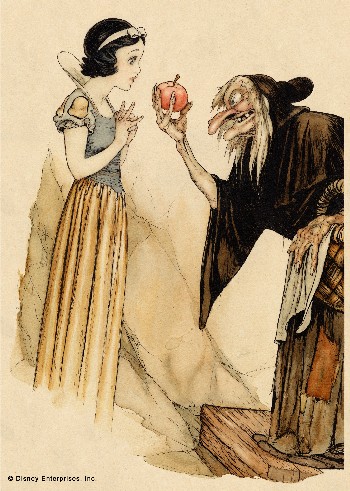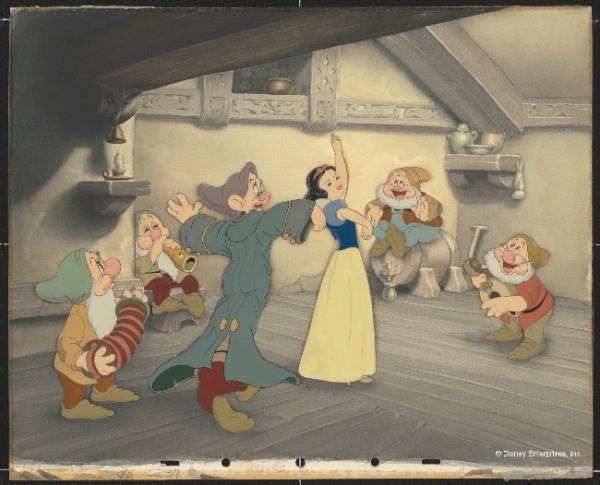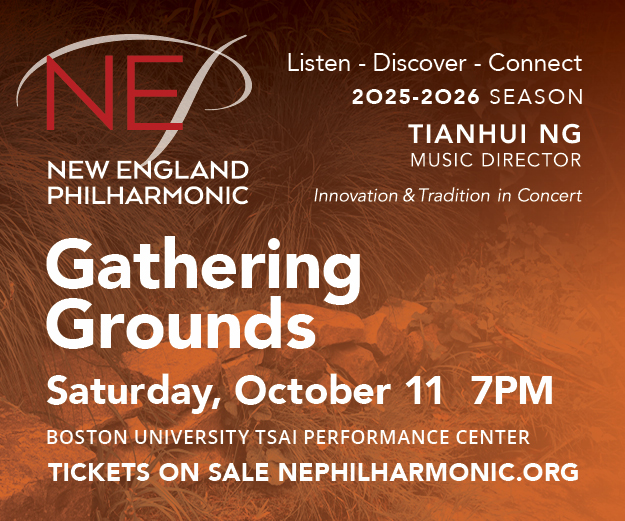Visual Arts Review: Heigh-Ho — Walt Disney’s “Snow White” at the Rockwell Museum
In four jam-packed rooms, in paper, acetate, and select video sequences, Snow White and The Seven Dwarfs: The Creation of a Classic deconstructs the film’s artistic and technical achievement.
Snow White and The Seven Dwarfs: The Creation of a Classic. At the Norman Rockwell Museum, Stockbridge, MA, through October 27, 2013.
By Debra Cash

SNOW WHITE AND WITCH WITH POISONED APPLE. Gustaf Tenggren Book illustration; watercolor and ink on paper Courtesy Walt Disney Family Foundation; © Disney
In March, 1941, Norman Rockwell created a cover for the Saturday Evening Post that distilled the impact of Hollywood on the sensibility of impressionable, American girls. In a tromp l’oeil effect, the face of an adolescent girl was hidden and replaced by the cover image on a different Post cover, this one the portrait of a haughty starlet whose pink lipstick perfectly coordinated with the mass of pink petals on her toque. The magazine’s open pages were held in the girl’s fluffy, white mittens and grounded by the mundane reality of the schoolbooks stacked on the lap of her parochial school, plaid skirt.
The artist signed the original painting as a special gift. “To Walt Disney, one of the really great artists — from an admirer, Norman Rockwell.” Disney apparently hung the picture in his office and returned the favor by sending Rockwell a set of ceramic figurines featuring characters from Pinocchio, Bambi, and Fantasia.
Aptly, the Norman Rockwell Museum in Stockbridge, Massachusetts — a place Rockwell aphorized as “the best of America, the best of New England” — has remounted an extensive exhibit marking the 75th anniversary of Disney’s Snow White and the Seven Dwarfs. The show, organized by The Walt Disney Family Museum in San Francisco with materials borrowed primarily from the Walt Disney Animation Research Library, is more than a whistling heigh ho down memory lane. It stakes a claim that the heroic project of creating the first, full-length animation was equal parts can-do American gumption, Taylorist assembly line, and inexplicable visual and narrative magic.
In four jam-packed rooms, in paper, acetate, and select video sequences, Snow White and The Seven Dwarfs: The Creation of a Classic deconstructs the film’s artistic and technical achievement. The exhibition moves from early concept art, story sketches, animation drawings, and background painting to final cel setups — with the front of the sheet inked and the back painted in full color — ready to be filmed at the rate of 12-24 hand drawn cels per second of finished animation.
Snow White‘s visual design speaks of deep observation and the adoption of art-historical techniques that are only really noticeable when you examine the background drawings and stills. The film’s annotated production sketches are particularly poignant, a glimpse into the ways artists kept each other on track and the zillions of images generated over the course of production organized. Seeing the artwork close up, it’s evident that Snow White had its roots in not merely the world of children’s fairy tales but, as curator Lella Smith argues, in the visual culture of then-contemporary cinema, appropriating elements from films like The Cabinet of Doctor Caligari.
The physical exhibition design at the Norman Rockwell Museum has the thought-through planning you’d expect from the Magic Kingdom’s heirs — a busy mix of archival materials and background information for the adults, video clips hung at kids’ eye level, and up-to-the-minute interactivity so that museum visitors can follow a scene of Snow White weeping in the forest from drawing to finished cartoon vignette by swiping an iPad.
I was particularly delighted to see clips from the live-action reference films of 13-year-old Marjorie Belcher —later to grow up to be the great MGM dance star Marge Champion — dancing in a version of Snow White’s standing collar costume so that the animators could take a rotoscope tracing of her motion to duplicate frame by frame. (For a thorough description of how the Disney studio turned live dance into animated footage, check out Mindy Aloff’s 2008 Hippo in a Tutu). Champion, who modeled for Pinocchio‘s Blue Fairy as well as a Dancing Hippo in Fantasia, is now a Stockbridge resident and was feted at the museum’s opening. A sample of her reminiscences are below:
Snow White was created by a cadre of “32 animators, 1032 assistants, 107 inbetweeners (the artists who create the intermediate frames between the key frames to create a cartoon’s sense of motion), 10 layout artists, 25 background artists, 65 special effects animators and 158 inkers and painters and countless production staff.” There was, according to a famous quote from Walt Disney, “no compromise on money, talent, or time.”
The exhibit brings to light the names and contributions of the specific artists in the Disney studio’s employ: the way Joe Grant envisioned the dangerously beautiful queen turning, in flashes of X-ray lightning, into the warty witch; the Swedish born Gustaf Tenggren, whose vision of rural, European architecture decorated the dwarfs’ cozy cottage; the Dickensianly-named Grim Natwick (whose original name, alas, was Myron, but whose style in early Snow White drawings repurposes the distinctive gait of a previous American icon, Betty Boop).
A wall label assertion that Disney “was intent on having each film from the Disney Studio viewed as a unified whole, rather than a composite of parts made by many individuals” is at best disingenuous. What would it have hurt to have the artists sign their names to work that was bound for the studio archives? In Snow White and The Seven Dwarfs: The Creation of a Classic, there’s not a whiff of indication that the same year Rockwell was sending Disney that Post cover as a token of his esteem, the animators at Disney had gone on strike, partly in response to “Uncle Walt’s” refusal to pay the legally required time and a half for overtime during Snow White‘s high stakes, high pressure production. Talk about digging in the mines! After the strike — it happened during the development of Dumbo — Disney fired a number of animators and others left to resume their careers at competing studios and small shops. Ultimately, laboring in the trenches of Snow White turned out to be invaluable training for many graphic artists joining an emerging industry. There’s enough information in this Snow White exhibit to form the basis of a dissertation comparing the nascent business structures of the Disney enterprise to the emergence of computer animation at training grounds like Lucasfilms’ Industrial Light and Magic.

SNOW WHITE DANCING WITH DOPEY AND SNEEZY. DOC, HAPPY, BASHFUL, SLEEPY PLAYING MUSIC. Disney Studio Artist Reproduction cel setup; ink and acrylic on cellulose acetate Courtesy Walt Disney Animation Research Library; ©Disney.
Disney’s huge risk paid off. A film that innovated with new technology—multiplane Technicolor aligning up to seven layers of artwork — cost $1.6 million to make, over $26 million in today’s dollars. The box office for its LA opening Christmas week of 1937 wasn’t constrained by a nasty Depression downturn. The cartoon was an international hit (in the Italian poster on display in Stockbridge, it’s “Biancaneve ei sette nani“) and of course Snow White continues to pay the Disney company dividends from the film itself and its endless stream of licensed products (float Doc, Happy, Grumpy, Bashful, Sleepy, Sneezy, and Dopey in your bath tub!). Uncle Walt’s empire would introduce a procession of Disney Princesses that waited around for romance, increasingly saccharine and interchangeable, until parents’ calls for more active and multicultural heroines bucked the trend, although the fight for feminism in the Magic Kingdom is far from over. But Snow White herself would continue to deliver the message that while being white as snow might be nice, kindness and friendship are the greatest virtues of all.
Norman Rockwell and Walt Disney really were kindred spirits: each managed to find a formula that spanned critical and commercial success. It’s not a mistake that the American Film Institute named Snow White the Greatest Animated Film of All Time. Heigh ho, indeed.
Debra Cash, Executive Director of Boston Dance Alliance, www.bostondancealliance.org, is a founding Senior Contributor to The Arts Fuse and a member of its Board of Directors. In 2017 she was honored as Champion of the Arts by OrigiNation Cultural Arts Center.
c 2013 Debra Cash


What an incisive and adroit critique!